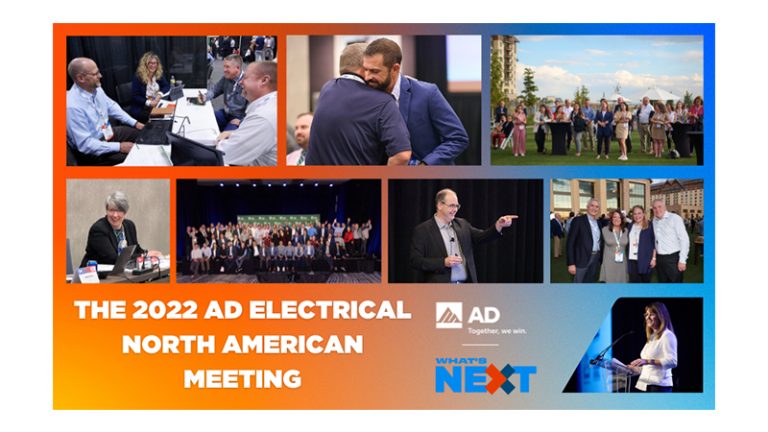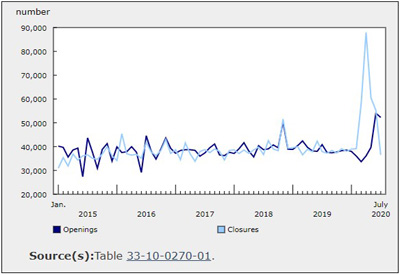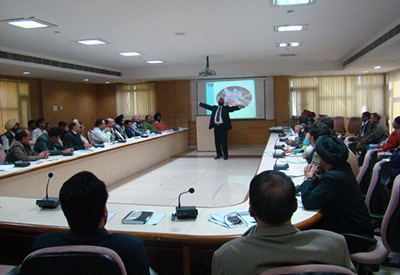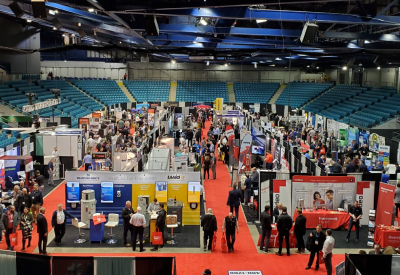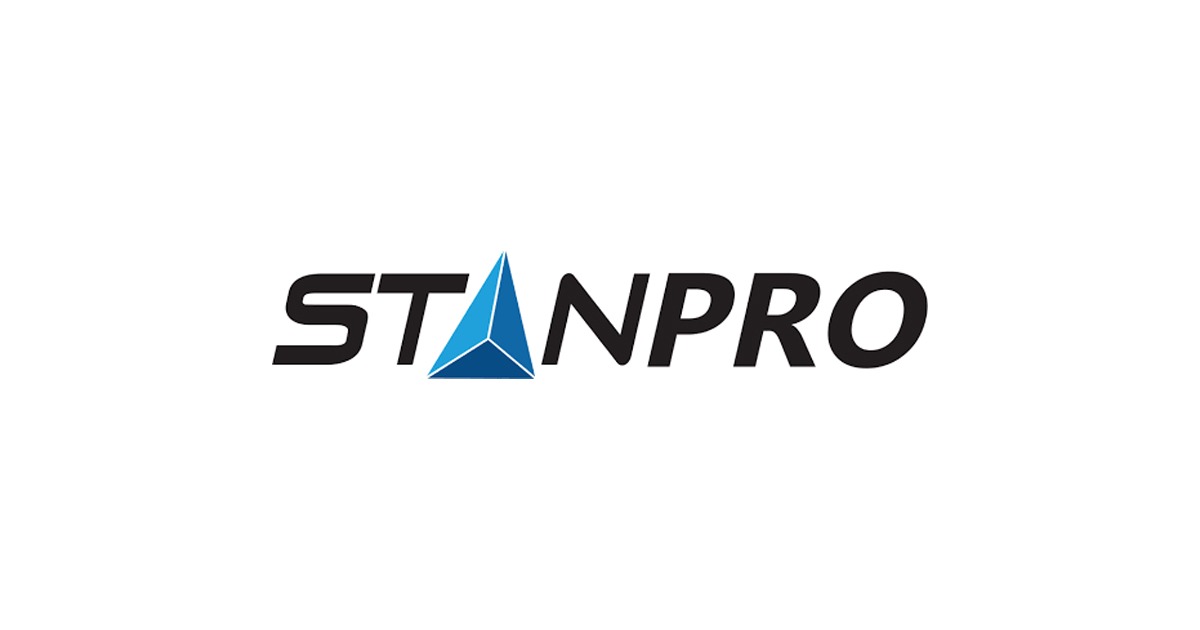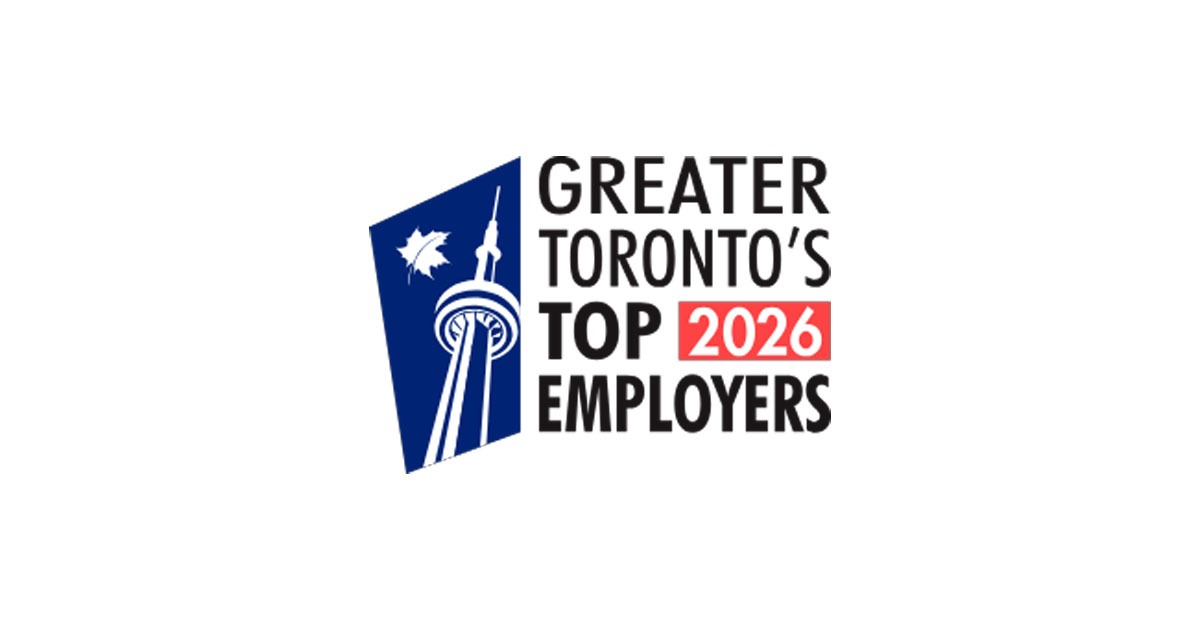Clearing the Air: Spotlight on Ceiling Mounted Air Purification
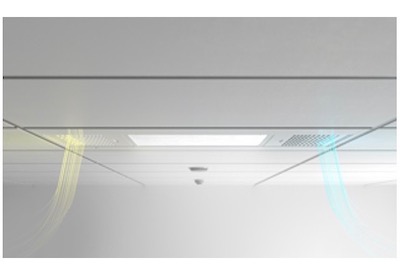
December 15, 2020
By Angela Jamieson and Marc Laplante
The importance of clean air has been thrust into the spotlight with the emergence of COVID-19 and the rapidly spreading infections related to it. Examples have emerged around the world showing how aerosols may be playing a role in transmission; the choir practise in Washington State where over 80% of their members were infected (primary or secondary)1 after their final practice before shutting down for COVID restrictions, or the restaurant in Guangzhou, China where COVID-19 was theorized to have spread according to the air movement from an air conditioning system2. These examples and many others have resulted in over 200 scientists urging the WHO to recognize COVID-19 as airborne3. Finally, on October 5, 2020, the CDC updated its guidance to include the potential for airborne spread4.
Despite COVID-19 being the current threat, we must prepare ourselves for what is to come. Cleaning the air on a consistent basis (24/7 or at least while an indoor space is occupied) is the best complement to proper surface disinfection to ensure the cleanest environment possible. Most people don’t realize that air can be more contaminated than surfaces and can be reservoirs of infection. Small airborne particles move through the space powered either by a sneeze or cough, or air currents created by HVAC systems and movement. As you watch dust particles settle on your coffee machine, you can imagine pathogens, such as viruses and bacteria, can move through the air because they are so much smaller. If we can purify the air, we reduce the risk of infection transmission simply because there are less infectious particles in play. In addition, surfaces can also be cleaner because pathogens can be neutralized or removed before they settle. Of course, no single method is a silver bullet to stop all infections from happening but creating an environment that is as clean as possible (through sanitizing air and surfaces) in addition to washing your hands and maintaining social distancing, are your best chances of minimizing your risk.
This article is to inform you of some of the newest products available on the market to help with air purification, why they work and what their benefits are over products currently on the market.
The products in focus are ceiling mounted air purification products. Although some models have been around for a few years, newer models are more aesthetically pleasing with downlight fixtures so that air purification can be integrated right into the lighting design. In essence, the product is a normal lighting troffer that fits easily into a T-bar ceiling, can be recessed into a drywall ceiling, or mounted on top of a hard (i.e. concrete) ceiling using a simple mounting box. The mounting box can also be suspended, creating a sort of pendant light. There are vents on either end of the fixture where fans draw up air through a coarse pre-filter (usually a MERV6). The only objective of this filter is to remove larger dust particles to keep the fixture working optimally. A filter with higher specifications, such as a HEPA filter, would keep infectious particles on the filter (and therefore live and infectious when you change it!) instead of letting them pass into the fully encased UV-C chamber on the back of the fixture. The chamber should not allow any UV-C light to escape so as to protect the occupants of the room. The chamber has been engineered to effect a very high first-pass kill rate on a wide range of pathogens (e.g. viruses, bacteria, fungi, mould) by having a low air speed (usually 50 cfm) and high intensity UV-C dosage (usually around 200-300 J/m2). Higher air speeds reduce the efficacy. That is why UV-C in HVAC systems, which is installed to reduce the bio-film on coils, is not effective at cleaning the air. The air in HVAC systems simply moves too quickly. COVID-19 and all coronaviruses are very susceptible to UV-C and will be effectively neutralized. Finally, the purified air is pushed back out into the room through an angled grille to prevent recirculation of the same air.
Why are these systems the best complement to surface cleaning?
1. The units can run 24/7, working to keep the background pathogen load low. Surface cleaning is episodic and is the cleanest when cleaning is just completed. Other products such as UV-C robots and fogging machines fit here as well. They achieve a superior surface clean (and in some cases, air, as well) but once you open the door to take the machine out, contaminated air and subsequent room occupants start introducing pathogens once again. Without continuous cleaning, the background pathogen load may increase to levels that result in transmission of infection.
2. The ceiling mount helps draw up pathogens from head level, where most pathogens are expelled (humans are the source of infectious particles!). The active draw to the ceiling keeps infectious particles moving upwards and theoretically away from occupied spaces. The air movement is also less impeded by the location of humans and furniture.
3. The slow air speed does not whip up pathogens that have already settled onto surfaces. Some air units have very high air speeds (and therefore UV-C is not very effective) but could also cause particles that have already settled on surfaces (ready to be captured by surface cleaning) to be airborne. The units are also helped by movement in the room where stagnant air can be included in the air stream. Air supply and return can also boost the impact of the ceiling mounted units.
4. The units are recirculation units and treat the air IN the room; something that is not being done with HVAC systems. HVAC systems move the air throughout an entire building. There have been incidents around the world showing how COVID has spread through condos and apartment towers and where the HVAC system is suspected5. Opening windows and having more fresh air incorporated into the space is a great idea but not always a workable solution in Canadian weather extremes. These units can also help create better air quality in buildings where the HVAC system is under performing.
5. The units are an engineering control which ranks highest in effectiveness (see Figure 1) because they don’t involve human intervention (besides annual maintenance). Essentially you can install and then forget about it until it’s time to do maintenance (usually once per year for 24/7 usage). Standalone units (those that sit on the floor or on a table) also work in the background, but they are more often than not, layered filter systems that require substantial maintenance. If the maintenance is not done on a regular basis, this affects the efficacy of the product. Standalone units are considered administrative controls. UV-C robots and fogging machines are also considered administrative controls because they require scheduling and human intervention to be operative and are quite labour intensive. PPE are the lowest in effectiveness because, although essential in some circumstances, compliance cannot be guaranteed (whether in wearing properly or wearing at all).
6. They take up no real estate in the room. Standalone products have cords to trip over and some rooms already have quite a bit of equipment that take up essential space.
7. They are simple: a pre-filter to remove dust and then high intensity UV-C. No fancy filters because UV-C is so effective it is really not required. The advantage is that there is less to maintain and less to go wrong.
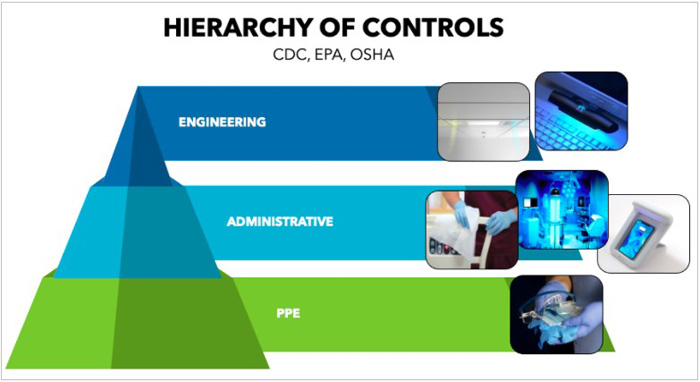
Figure 1. Hierarchy of Controls
Learning from history: Upper Room UVGI
Upper Room UVGI (Ultra Violet Germicidal Irradiation) has been in existence for decades, often playing a role in keeping wards containing people suffering with tuberculosis and influenza (well-known airborne diseases) safer for workers and containing the spread. Louvered units are installed on the walls and UV-C rays are shone upwards towards the ceiling. The natural air movement in the room created by supply and return air flow passively allows the room air to be treated. The method was very successful, reducing transmission rates in numerous applications which have been extensively documented in the literature. The problem with UV-C light is that it will affect all biological material, even humans. It also doesn’t bend but it does reflect. As a result, some room occupants started suffering from skin and eye burns. Eventually exposure time limits were placed on these rooms. Despite the after-effects, it is clear that Upper Room UVGI (UV-C) is effective. In fact, the CDC (Centers for Disease Control and Prevention) and IES (Illuminating Engineering Society) recommend Upper Room UVGI as a method to combat COVID-19.
Improving on history
The new products build on this success by creating active air flow, drawing up room air to the units and not only relying on HVAC air movement. The UV-C is now fully contained, allowing the power of UV-C to be used in occupied spaces without the danger of eye and skin burns. You can think of these new products as the “wheels on the suitcase” to the previous generation of Upper Room UVGI. The design is simple, but effective. As previously mentioned, there are no additional filters besides the pre-filter and therefore annual maintenance is simply changing the pre-filter and the UV-C bulb.
Modern additions
In addition to harnessing the power of UV-C, more features have been developed for the ceiling mounted air purification products. Downlight can be in the form of fluorescent or LED tubes, or fully dimmable LED arrays. In some models, Artificial Intelligence (AI) has been included to monitor the health of the UV-C bulb as well as the functioning of the fans and air speed. The information is instantly available on your device and ensures optimum performance of the device.
Help your customers find solutions to the COVID-19 problem while preparing themselves for whatever emerges in the future.
Angela Jamieson, Row 5 Distributors, Canadian Distributors of UV Angel products and Marc Laplante, Laplante et Associés, www.laplante.co.


